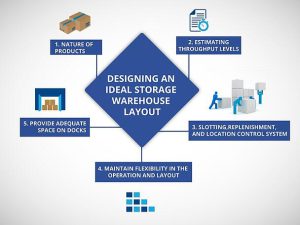The warehouses have grown from its basic function as a storage house to an intelligent component of the entire value chain. Warehouse design, most suitable material storage systems and efficient operations are integral to the success of a business, especially in the age we live in and are progressing towards.
But, how do you achieve efficient warehousing operations?
The answer is, through flexible and scalable warehouse racking layout and operations. Achieving flexibility should be goal of every warehousing manager, especially in today’s ever changing and complex operating ecosystem.
Much like the maintenance of your machinery or production unit is necessary, so is the upkeep of your warehouse. However, some businesses might overlook the telltale signs that their warehousing and storage systems need some tender, love and care. And while managers are well aware that a stitch in time can save nine, they still like to postpone the reassessment and overhaul of their warehouse operations till damage is done.
We’ll let bygones be bygones and rather help you with the realignment of your warehousing and industrial storage racking with these cues.
- Storage Material
Businesses are constantly evolving and planning to become bigger and better. With product lines being increased and production volumes being ramped up, storage solutions too will need to be reconfigured to holistically support the storage material, operations parameters and better customer service. It might be possible that your new product line needs to be stored and accessed differently than your previous goods – making this a sign that your warehouse needs reassessment and some kind of change and reconfiguration.
- Material Flow in the Warehouse
While the racking layout of the warehouse is integral to its operational efficiency, making changes to reflect alignment with the operational parameters is necessary to ensure meeting customer service objectives and also to be future-ready. When you are facing delays in obtaining the goods from the location it was stored at or even experiencing bottlenecks when storing inventory – it is a clear sign that the racking layout needs to be brought to speed with your needs. Each business and operational challenges are different and so one-size-fits-all approach for storage solution rarely works. Revising the storage systems and layout that complement your needs will ensure smooth operational flow. It’s also important to ensure that the revised layout is flexible or scalable for unknown future business changes or fulfilment model.
It is essential that the material flow has a logical sequence of operations and are as close as possible within the warehouse. Warehouse managers need to ensure uninterrupted movement of material, people and traffic with no cross flow clashes or congestion. The time lost due to work chain break is significant.
It is also concerned with the awareness of where material is located within the storage system, and the status and location in the storage and handling equipment and medium. Our aim is to site and position the various warehouse activities in order to contribute to a smooth flow of operations with a minimum amount of movement and disruption.
- Warehouse Storage Capacity and Throughput Levels
It’s likely that the storage systems were designed for the previous products, may be not be suitable for the products/SKUs being stored now in terms of utilizing the cubic space in the warehouse. It is essential to consult the warehouse storage expert and carry out the assessment to make necessary modifications to the existing racks or moving the existing racks to another operation/location and install most suitable racking for the existing products and operations. It’s important to ensure that vertical space as well as ground level square feet is utilized to the most extent possible.
When you have more products to store and more turnover to be achieved, moving to a new location and expansion is not always the option. You need to step back and refocus on the key areas, such as, slotting, replenishment and location control system.
Also, when the demand is more and pressures are paramount it is possible to mix up SKUs in confusion. Through efficiently understanding your stock and storing it right such fallacies can be avoided all together.
If you are missing out on achieving throughput levels, then, it’s the time to revisit the storage systems being installed.
To follow the management mantra ‘do more with less’, you need to constantly keep a watch on inventory carrying costs and inventory value. Each business has fast moving, medium and slow moving goods and very own season where the outflow of goods is more frequent. Sometimes, inefficient racking layout and storage systems reduces the stock visibility, which results in unknowingly using the most precious racking space for storing the obsolete material for a long period of time. Every warehouse manager strives to maintain a lean inventory to avoid blocking of financial resources and drive higher efficiency and productivity. Hence, it’s most critical to check the inventory efficiency and take a call on warehouse layout and storage system reassessment.
- Value Added Services
With the rapid changes in marketplace and customer preferences, it is important to stay ahead of the curve to survive and grow. Businesses are striving to make differentiation with value added services. A simple change that still goes a long way is to teach your staff and educate them about the various protocols that you follow and why they are necessary.
The services areas such as kitting, bundling, bulk breaking including inbound/outbound docks areas to be re-looked to support the changing operational requirements.
- Warehouse Racks Slotting
The movement of people and inventory is another crucial indicator that can help you identify whether some changes are due or not. While some goods need to be shipped on a regular basis in high volumes, others might need to be stored for long periods of time or retrieved occasionally. It is important to periodically analyse and make necessary changes to the racks slotting to drive efficiency in most labour intensive tasks such as put-away, picking, bundling, packing and dispatch. It also helps in reduction in material damage by avoiding multiple human interactions with the products.
- Inbound and Outbound Operations
The warehouse should be able to facilitate multiple techniques such as cross docking and wave picking, among others, especially if these are causing delays in the process of inbound and outbound operations. Also, depending upon the pick-up type, each warehouse is divided into multiple zones. This division could be redesigned to help facilitate faster delivery of goods.
- Labor Efficiency
While it is the age of automation, humans still have the upper hand in warehouse operations and logistics. The warehouse automation requires certain scale and size to make it feasible. Few large and medium warehouses still depend on labour to meet their warehousing and customer service objectives. Hence,It is important to check few key parameters such as number of picks per hour, accuracy, order fulfilment rates, fork lift usage etc to analyse and make necessary changes to the layout or process to improve labour efficiency.
No change in your warehouse will be small. Having said that, even a slight improvement might result in significant productivity boosts for the unit – therefore it is best to make the change now than push it for later.
If you feel your warehouse is under-utilized or has some problem, pls leave your comment or drop in a mail. Our consultative sales team will be happier to team up with you and come out with the actionable steps for unleashing the true potential of your warehousing.
Topics: Warehouse Storage Layouts, Warehouse Optimization, Warehouse Operations




